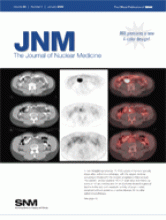Abstract
11C-Loperamide is an avid substrate for P-glycoprotein (P-gp), but it is rapidly metabolized to 11C-N-desmethyl-loperamide (11C-dLop), which is also a substrate for P-gp and thereby contaminates the radioactive signal in the brain. Should further demethylation of 11C-dLop occur, radiometabolites with low entry into the brain are generated. Therefore, we evaluated the ability of 11C-dLop to quantify the function of P-gp at the blood–brain barrier in monkeys. Methods: Six monkeys underwent 12 PET scans of the brain, 5 at baseline and 7 after pharmacologic blockade of P-gp. A subset of monkeys also underwent PET scans with 15O-water to measure cerebral blood flow. To determine whether P-gp blockade affected peripheral distribution of 11C-dLop, we measured whole-body biodistribution in 4 monkeys at baseline and after P-gp blockade. Results: The concentration of 11C-dLop in the brain was low under baseline conditions and increased 5-fold after P-gp blockade. This increase was primarily caused by an increased rate of entry into the brain rather than a decreased rate of removal from the brain. With P-gp blockade, uptake of radioactivity among brain regions correlated linearly with blood flow, suggesting a high single-pass extraction. After correction for cerebral blood flow, the uptake of 11C-dLop was fairly uniform among brain regions, suggesting that the function of P-gp is fairly uniformly distributed in the brain. On whole-body imaging, P-gp blockade significantly affected distribution of radioactivity only to the brain and not to other visually identified source organs. The effective dose estimated for humans was approximately 9 μSv/MBq. Conclusion: PET with 11C-dLop can quantify P-gp function at the blood–brain barrier in monkeys. The single-pass extraction of 11C-dLop is high and requires correction for blood flow to accurately measure the function of this efflux transporter. The low uptake at baseline and markedly increased uptake after P-gp blockade suggest that 11C-dLop will be useful to measure a wide range of P-gp functions at the blood–brain barrier in humans.
Footnotes
-
COPYRIGHT © 2009 by the Society of Nuclear Medicine, Inc.







